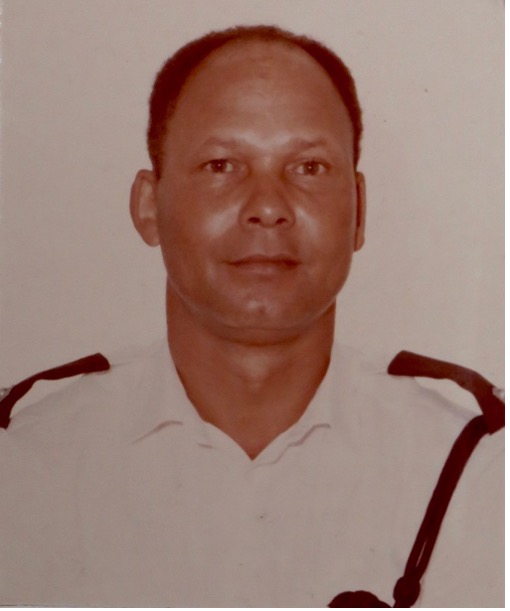 Chief Inspector Hilton “Jelly Bean” Wingood
Chief Inspector Hilton “Jelly Bean” WingoodHilton Barclay Wingood was born in Warwick on 13th April 1932, the son of Elmo and Mildred Wingood. His father was an upholsterer at the Royal Naval Dockyard. As a young boy Hilton attended a neighborhood school on Cooks Hill and then West End Primary School. When he was 8 years old the family moved to Somerset. Hilton had two younger sisters, Lilian and Marlene.
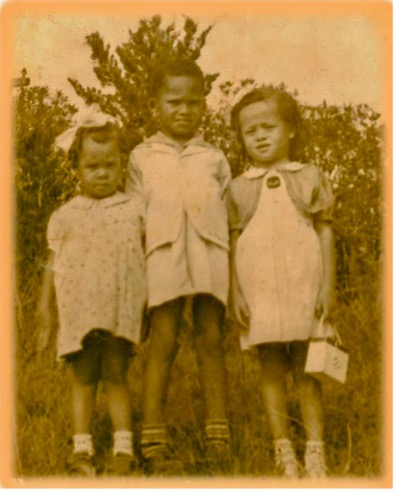 Hilton and his two sisters,
Hilton and his two sisters, 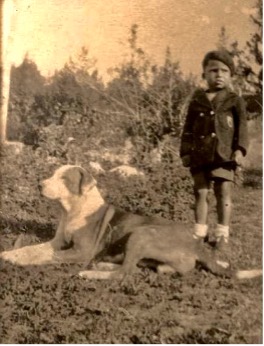 Hilton and his dog
Hilton and his dog Hilton left school at the age of 12, and at the age of 13 Hilton took extra-curricular classes to be able to apply for a position as an apprentice at the Royal Naval Dockyard, and after passing the course he started work when he was 14 as an apprentice carpenter in the Dockyard Apprenticeship Programme. He and his fellow apprentices would ride their second-hand or “third-hand” pedal bikes, purchased from George Todd or George Ratteray, to be at work for 9am.
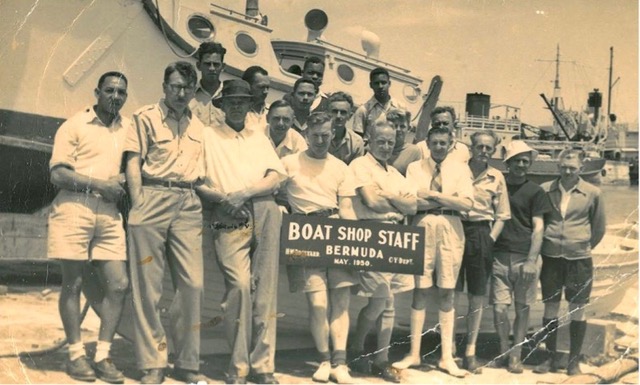 Hilton and the Boat Shop Staff at Dockyard – May 1950
Hilton and the Boat Shop Staff at Dockyard – May 1950
The Dockyard school and its apprenticeship progamme were in sharp contrast to the segregated education system in Bermuda at that time, but in 1950 the Royal Naval Dockyard officially closed, and there was a dilemma about what would happen to all of the young Bermudians doing their apprenticeships. Through the generosity of the Royal Navy it was decided to offer all of the apprentices an opportunity to complete their apprenticeship training in England.
Hilton was one of 49 young Bermudian Dockyard apprentices who were selected to complete their apprenticeship training in Portsmouth, England
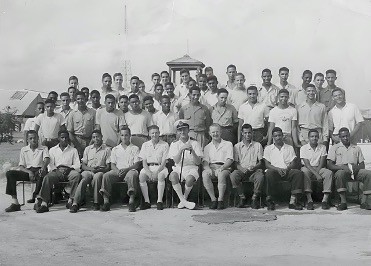
This group of apprentices included Alan “Harry” Lister who had joined the engineering programme at Dockyard where he served for 3 years before being invited to join the apprenticeship programme in Portsmouth. Also included were two other young men who eventually went on to join the Bermuda Police, and they were Howard Dill and Neville Phillips.
The 49 young men boarded the MV Georgic and set sail to England on a new adventure. Young Alan “Harry” Lister recalled leaving his home on Heathcoate Hill in Sandys Parish pushing his trunk in a wheelbarrow.
 MV Georgic
MV Georgic
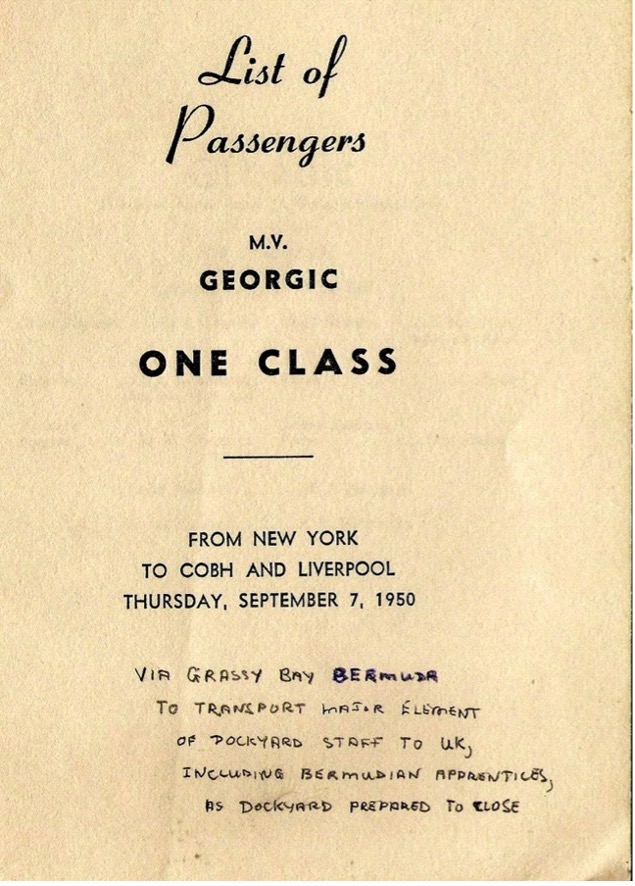
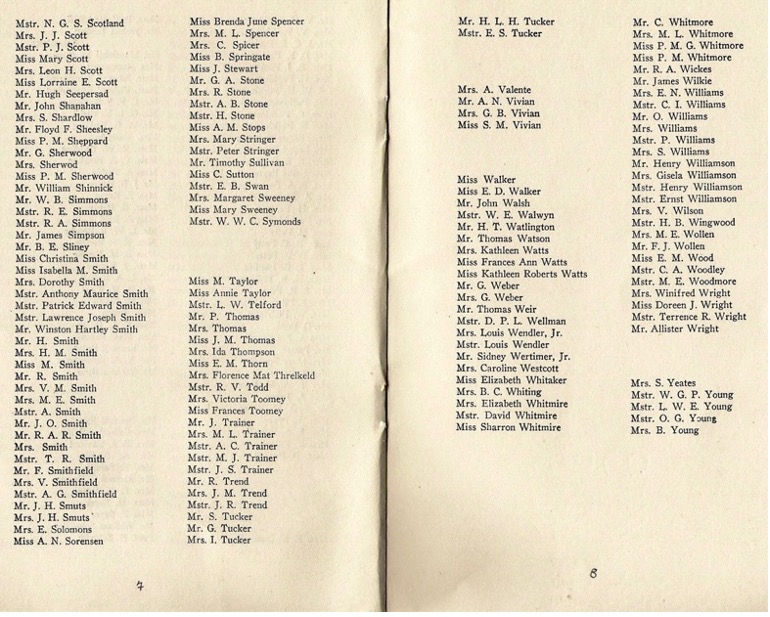
CLICK HERE for a fascinating article written by Cecille Snaith-Simmons and published in the Royal Gazette on 19th July 2023.
In the article Hilton had described his journey on the MV Georgic and his arrival in Portsmouth as follows:-
"He was 17 when he left for Portsmouth on that racially segregated ship. The “Coloured boys” were in the bow or forward part of the ship, where they remained for the entire journey. In the Irish Sea, he witnessed the biggest waves he had ever seen. They were not permitted to leave their assigned area. They ate, slept and socialised there. He had no complaints about the food, experiencing rice for the first time as a dessert — rice pudding with raisins!
In Portsmouth, nine of them were assigned to one room with one bathroom. They vehemently protested the next morning and were immediately moved. They were served potatoes and cabbage every day with desserts of rhubarb and frequently prunes. Meat was rationed.
In the yard they worked in gangs of 50 with an instructor and formed sports teams."
During my interview with Hilton he described his arrival and his time in Portsmouth:-
“When we first arrived in Portsmouth we were put in terrible accommodation on the first day, with 9 or 10 of us in one room and sharing a bathroom. We very quickly complained and later the same day they found us alternative accommodation.
“Our group were doing different trades and I was an apprentice shipwright. We were called 'Jack-of-all-Trades!' One of my first jobs was working on strapping up the stern of HMS Victory.
“During our time off each group of about 16 men, Englishmen and Bermudians would play all kinds of sports. Some would play football or cricket, while others would do cycling or basketball which was very popular then because the Harlem Globetrotters were touring England doing exhibitions, and there were basketball courts at some of the schools. I played right half for our football team which had a few semi-professionals and our group were football fanatics!
“Portsmouth was a Navy Town when we were there. We had different ethnic groups and we all socialized together. We had a very active social life going to dances, movies on Sunday afternoons, and Friday nights at the Savoy where they entertained with travelling bands. There was never a dull moment and there was really no racism or segregation like we had in Bermuda.
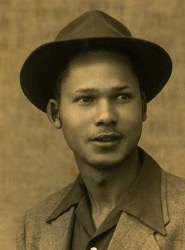 Young Hilton Wingood
Young Hilton Wingood
“I attended evening school once a week at the Metropolitan College which was free. For my apprenticeship I was in a class studying welding, and after 3 months as an underwater welder I became an instructor for a class of 14 students teaching them electric spot welding. I had really taken to welding. I also learned to write incident reports if we had any accidents while we were working.
“I moved into a room at 34 Thurbern Road in North End, Portsmouth. I had a very nice landlady who kept my ration book and would go to the market on Wednesdays for food and supplies. Everybody had ration books because there were still food shortages after the War, and foods such a meats and fish had to be rationed. The worst meal I remember having was potatoes and cabbage – no meat. I got used to having rice puddings for the first time.
“As soon as I finished my apprenticeship my mother wanted me to come home. She didn’t want me to marry no English girl! If I’d stayed I was due to do two years National Service and I decided to return to Bermuda. When I came back home as a qualified shipwright/welder I started working with the Board of Trade as a shipwright at Dockyard. Although the Royal Navy had left Dockyard the Government was still looking after it. We had a floating dock and would repair Government’s fleet of boats including ferry boats such as the Wilhelmina and Corona.
“I played a lot of football while I was in England and when I came home I played for West End Rovers with Fred Bean and Harry Lister who also finished up joining the Police Force.
“I also helped out my father with his upholstery business which he set up in Dockyard, and one Saturday I was working hanging up curtains at the home of Superintendent Percy Miller. We had a conversation and he asked me if I would be interested in joining the Police Force. In fact he told me I should join the Police Force. I think he was intrigued with my accent after I’d spent 2 years in England! This was at a time when most of the members of the Police Force were white, some being Bermudians and others being expatriates who had been recruited in the UK, and some of these had served in the Military.”
“There were very few coloured or black officers on the Force at that time but they included Hubert Simmons (joined June 1950), Milton Cholmondeley (joined Aug 1950), Gladwin “Doc” Hall (joined Oct 1950), and Dudley Swan (joined July 1951) These young men joined the Police Force at the height of segregation in Bermuda.
By coincidence, both ˝Gladwin “Doc” Hall and Dudley Swan married my two sisters. “Doc” married my sister, Lillian on 25th June 1953, and Dudley married my sister Marlene on 21st April 1953.
“Percy gave my father the application forms and I then had a medical followed by an interview with the Colonial Secretary and the Commissioner of Police, Mr. Henderson.
“They wanted to know why I would give up my job earning 14 pounds a week for a job in the Police Force earning 12 pounds a week. I told them I wanted to make a difference and serve in my community. I remember the Colonial Secretary saying that “your lot don’t have much chance of promotion. (Editors note - At that time, there was only one ‘coloured‘ officer who had ever been promoted to Inspector and that was Edward R. “Bosun” Swainson) in February 1949.”
CLICK HERE to view our Hall of Fame article on the legendary Edward "Bosun" Swainson who also scored the first century in Cup Match.
Hilton passed the entrance examination and joined the Police Force on 4th March 1955 as did Hubert Swan on the same date. Fellow apprentice Alan “Harry” Lister joined the following year, in March 1956.
Another former Dockyard apprentice, Edgar Durrant, joined the Police Force on 1st April 1955, just a few weeks after Hilton.
At that time overseas recruits in the 1950’s were required to attend a police training school in the UK for 3 months prior to coming to Bermuda so they had first class training before they arrived here. Local recruits, however, received the bare minimum of training before being put on the beat, usually in Hamilton.
After joining Hilton remembers that himself and Hubert Swan, along with “Sharkie” Stubbs (brother of Dr, John Stubbs) spent 2 weeks having lectures from Supt Miller from 9am-5pm, studying laws such as the Summary Offences Act, the Road Traffic Act and the Criminal Code. This was in an office on Victoria Street where the barracks were located. Hilton described how the young recruits kept notes in exercise books and were shown how to write up tickets.
Following the 2 week course the three men started on the beat in Hamilton, and Hilton remembers his first Sergeants were Harry Fisher and Leslie Burge. There were very few coloured officers working in Hamilton at that time, and Hilton described how most of the time he and any other coloured constables would be assigned to 3, 4 and 5 beats in the “back-of-Town” meaning north of Church Street. One of the other officers he went on patrol with was P.C. Webster Furbert who had joined about 2 years earlier.
CLICK HERE to view our Hall of Fame article on Webster Furbert.
When he worked on 1 and 2 beats it meant directing traffic but also doing traffic points at the bottom of Spurling Hill, on Cedar Avenue outside Mount St. Agnes School, and on Heyl’s Corner in the days before the birdcage.
Hilton described working in Hamilton as follows:-
“Every Watch in Hamilton had a duty driver and they drove an assortment of vehicles. I think we had about 8 or 9 men on each Watch, and there were only about 120 men on the Force then.
“After a few months (in December 1955) I was transferred to Traffic where Sgt John Marshall was in charge. We had about 18 men, with maybe 5 on each Watch. The ‘elite’ cars to drive in Traffic were the Sunbeam Talbots which were black, and fast. We also had Vauxhalls and they were black with a white roof and were called “white elephants”, and some Fords. Very often we would have one car on Island wide patrol and one guy on a motor cycle.
“For catching speeders we would have to follow vehicles for at least 3/10 of a mile and keep a record of the speeds. The Magistrates then were Mr. Minty and Mr. Godet. I had a driver’s licence before I joined the Police Force. I was the only coloured guy in Traffic for a while. I have to say some of the white guys wouldn’t drive with me.
“I was used to writing up reports from my time in Portsmouth and I would write up proper reports if I was dealing with accidents. The magistrates liked how I would describe the scenes of accidents and they classified me as an expert or traffic accident investigator. One year while in Traffic I supervised the reports for 9 fatal accidents.
“When I first started in Traffic we had to write long accident reports but myself and P.C. Bob Woolley, who was a graphic designer, designed a ‘Tick the Box’ form for dealing with accidents which made it much easier and quicker to do reports.
“These were the early days of Traffic and it was still very basic in some ways. I remember when Harry Lister and Fred Bean were both posted to Traffic and they were both good mechanics and were servicing the police cars. Charles "J.J" Williams was also posted to Traffic.
‘This was around the time when Lois Browne-Evans said the Police Force was “too creamy – more chocolate is needed!” Maybe for that reason I had Fred Bean as my partner because he was the blackest P.C. in Traffic, and we drove one of the last Sunbeam Talbots. It was fitted with Pirelli racing tyres, had 5 gears, fuel injection, a new style carburetor, and was a really fast car. I was given the keys and no-one else could drive it for about 3 months except for me and Fred Bean. The number was P7410 and we were called “The Black Knights”! This Sunbeam Talbot was too expensive and no more were brought in. It was a very good car to drive.”
Whichever car young Hilton was driving while he was in Traffic, he certainly came to the attention of Commissioner Henderson because during a spell of less than a year, his personal file at Prospect revealed that he was awarded no less than 4 Commissioner’s Commendations as follows:-
- In July 1958 Hilton received a Commissioner’s Commendation for persistence in chasing and apprehension of a dangerous driver who was later convicted;
- In February 1959 he was commended and awarded £5 for devotion and zeal in the apprehension of two speeders who were disqualified from driving;
- In March 1959 he was commended and awarded £5 for zeal and devotion to duty in dealing with two cases of removed autocycles;
- In April 1959 he was commended and awarded £5 for the apprehension of a person for dangerous driving.
When describing his time in Traffic Hilton said, “Sometimes I would work a shift from 11am – 7pm and one of my duties was to relieve the Hamilton Station Constables from 6pm-7pm and also to relieve the Duty Officer (Radio Operator) at Traffic from 1pm-2pm. At that time the Station Constables were all white and I remember one in particular refused to hand over to me. He would just walk out of the Station when we were changing shifts“. There were other times during his career when Hilton felt that he was not treated fairly because of his colour.
It was also while serving in Traffic that Hilton was involved in the serious situation at Hamilton Docks in September 1959 when the dockworkers, led by ‘Porkchop’ Mills took industrial action to protest against conditions on the docks. This was Bermuda’s first major civil demonstration. Hilton recalled that he was working in Traffic with P.C. Alan Lister at the time and they were ordered to pick up wicker shields and batons. They were part of a police unit that marched down Front Street to No. 1 Gate in riot gear with no training in riot control. Also marching with them was a 6 man rifle squad, armed with 303 rifles. This group included Kenny Roberts, “Bongo” Williams and four of the English guys.
Hilton was on the front line at the docks facing the dockworkers who were armed with all sorts of weapons, and he heard Magistrate Mr. Grey, standing on the balcony of one of the shops, reading the Riot Act to everyone assembled there. Fortunately, the dock workers dispersed and went off into the back of Town, while a group of men labelled “scab labour” by the dock workers continued unloading the ‘Queen of Bermuda.’
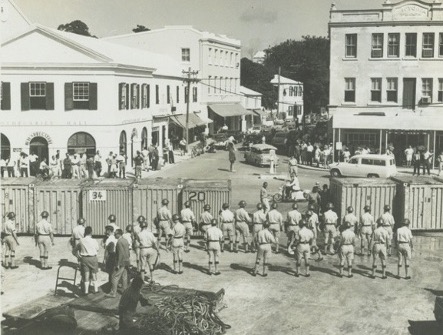 A potentially explosive situation on Hamilton Docks -1959
A potentially explosive situation on Hamilton Docks -1959
On a more positive note, in June of 1961, Hilton married the love of his life, Miss Brenda Morrisey, and as of this writing Hilton and Brenda are still happily married after 63 years.
Their daughter, Lisa Mirranda Anne, was born in December 1963, their first son Trevor Barclay, born in January 1965, very sadly died at the age of 2, and their second son, (Hilton) Garon, was born in June 1971.
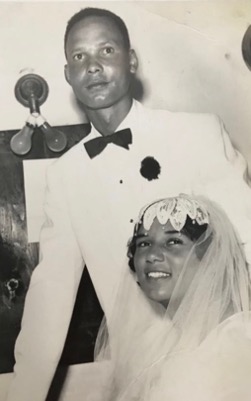
Hilton and Brenda on their wedding day
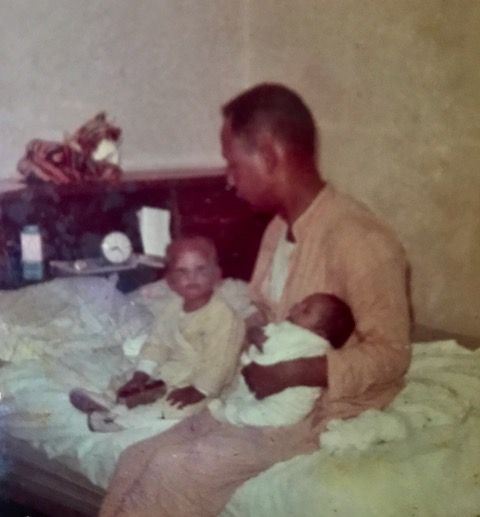 Proud father Hilton with Lisa and baby Barclay Trevor
Proud father Hilton with Lisa and baby Barclay TrevorAfter 7 years in Traffic, Hilton was posted to Western Division where he spent 3 years in uniform before being transferred to Western CID.
Hilton described how in the early 1960’s the new Commissioner, George Robins, promoted several ‘coloured’ policemen on “merit” who hadn’t passed the promotion exams, and they included Eddie “Boxhead” Foggo, Custerfield “Custy” Crockwell and Harry Lister. After Harry Lister was promoted, Commissioner Robins was upset when he saw Hilton not wearing stripes because the Commissioner had apparently made a mistake and had intended to promote Hilton. Commissioner Robins ordered Hilton to take his Sergeant’s promotion exam as soon as possible, and after he passed it in February 1963, Hilton was made Assistant Provost Marshall and worked as a process server.
He was promoted to Sergeant in September 1964 at which time he was transferred to Central Division as a Watch Sergeant. While being interviewed for this article Hilton commented that being a Watch Sergeant in Hamilton were some of best times of his police career. He noted that Hamilton was very busy in those days with lots of tourists, the Queen of Bermuda and the Ocean Monarch were docking every week, the cargo docks were operating at full capacity, and the bars and nightclubs were hopping. I happened to be on his Watch when he was first promoted to Sergeant and our watch consisted of all young English constables plus one Bermudian, Gilmore Simons. Sgt. Wingood was a popular Sergeant who always treated us fairly.
It was while serving in Hamilton as a Sergeant that he received another Commissioners Commendation in October 1966 for zeal and initiative in a case of stealing. Hilton also served as Supreme Court Officer while he was a Sergeant in Hamilton.
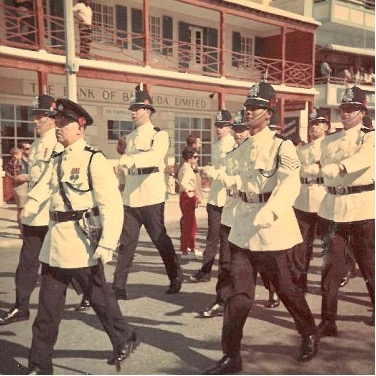 Sgt Wingood marching along Front Street on November 11th Parade
Sgt Wingood marching along Front Street on November 11th Parade
Following 3 years as Watch Sergeant in Hamilton, Hilton was transferred to Operations (Traffic) in 1967.The following year he was made OIC Cycle Squad, and it was while serving in Cycle Squad that he attended a 3 month General Duties Course at Bishopgarth near Leeds in Yorkshire, together with Sergeant Gerry James and officers from Africa and the West Indies. During the course Hilton recalls attending entertainment clubs in the area with live music and bands, and he also attended football games at Elland Road to watch Leeds United playing during the season they went on to win the 1968-1969 Football League title.
Hilton remained in charge of Cycle Squad until April 1971 at which time he was posted to the Mobile Reserve Unit for several months before moving to Operations (Traffic) in June 1971. A year later he transferred to Training School as an instructor, then to Prosecutions in July 1973. Six months later Hilton was transferred to Western Division where he was promoted to Inspector the following month and became OIC Western Division. By this time Hilton had more than lived up to his reputation as a “Jack-of-all-Trades” while serving as an apprentice shipwright.
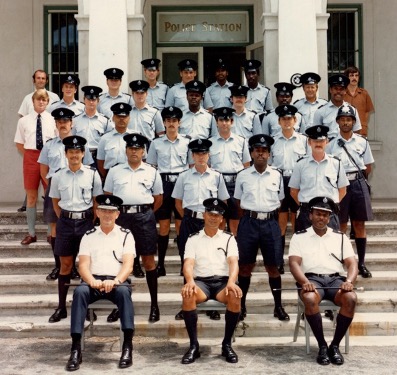 Western Division - circa 1973
Western Division - circa 1973Back Rows (l-r) Dai James, Damian Willcocks, Colin Hopkins, Mike Scully,Ben Linton,
4th Row - Dave Barber, Chris Bowerman, Keith Melville, Foster Burke,
3rd Row - Bill Buchanan, Mike Phillips, Harry Mesham,
2nd Row - Louis Griffiths, Sgts. Neville Phllips,
Front Row - COP L.M. "Nobby" Clark, Inspector Hilton Wingood,
As the officer-in-charge if Western Division one of Hilton’s first problems was how to deal with a group of youths who were hanging out and causing trouble on the main road in the area of Cricket Lane and Broome Street in late afternoons and evenings. Hilton dealt with it by stationing a Sergeant and two constable at the trouble spot at 5pm every afternoon, and that helped to solve the problem.
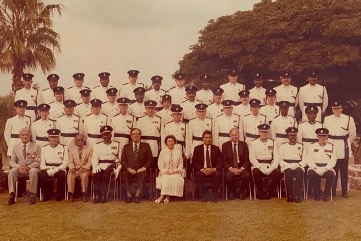
In January 1976 Hilton transferred to Central Division as a Watch Inspector in Hamilton at a time when the Police Force was going through restructuring and Hamilton was much busier than it was back in 1955 when Hilton first donned his police uniform as a young Constable on the beat. After serving as Watch Inspector from January 1976 - February 1978 Hilton’s next move was to CID, Murder Squad, where one of his assignments included house to house enquiries in connection with the murder of Connie Furtado.
In August 1979 Hilton returned to Western Division as OIC, and two years later he was promoted to Chief Inspector in November 1981.
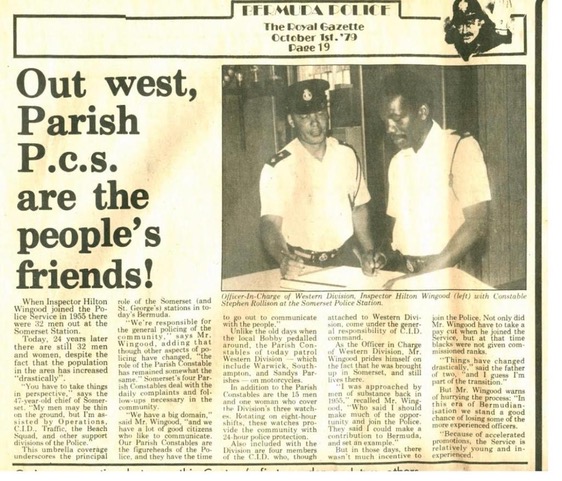 Article in Royal Gazette 1st October 1979
Article in Royal Gazette 1st October 1979
Shortly after moving to Western Division as Inspector in charge, Hilton was interviewed by the Royal Gazette at which time he pointed out that when he joined the Bermuda Police in 1955 there were 32 men at Somerset Station. "Today (1979) there are still 32 men and women despite the fact that the population in the area has increased drastically.“
"We're responsible for the general policing of the community," says Mr. Wingood, adding that though other aspects of policing have changed, the role of the Parish Constable has remained somewhat the same. Somerset's four Parish Constables deal with the daily complaints and follow-ups necessary in the community.
"We have a big domain" said Mr. Wingood, "and we have a lot of good citizens who like to communicate. Our Parish Constables are the figureheads of the Police, and they have the time to go out to communicate with the people."
As the Officer in Charge of Western Division, Mr. Wingood prides himself on the fact that he was brought up in Somerset, and still lives there.
"I was approached by men of substance back in 1955" recalled Mr. Wingood, "who said I should make much of the opportunity and join the Police. They said I could make a contribution to Bermuda, and set an example."
But in those days, there wasn't much incentive to join the Police. Not only did Mr. Wingood have to take a pay cut when he joined the Service, but at that time blacks were not given commissioner ranks.
"Things have changed drastically," said the father of two, "and I guess I'm part of the transition.
But Mr. Wingood warns of hurrying the process "In this era of Bermudianisation we stand a good chance of losing some of the more experienced officers. Because of accelerated promotions, the Service is relatively young and inexperienced"
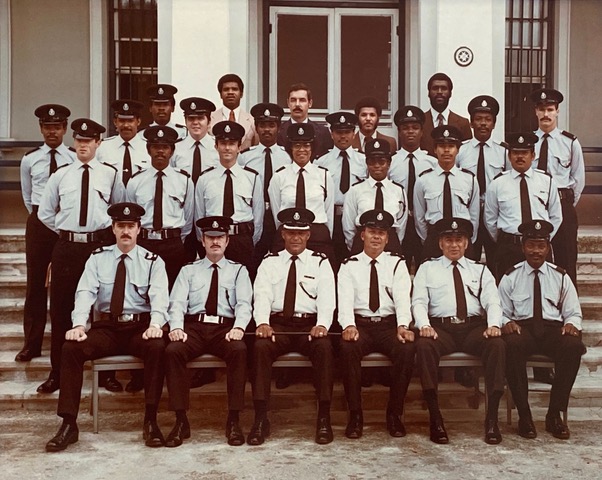
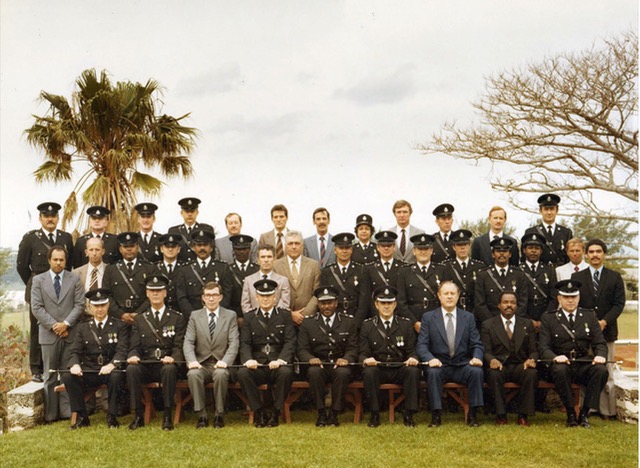 Bermuda Police Senior Officers - Late 1981
Bermuda Police Senior Officers - Late 1981Hilton was a regular member of the Police Choir since the early 1960’s and throughout his career.
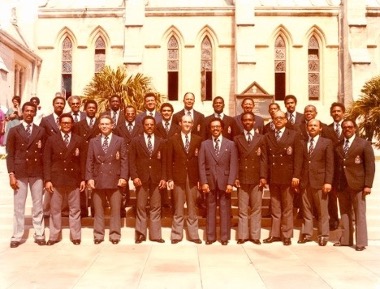 Police Choir
Police ChoirAt the time of compiling this article Hilton and Brenda were still residing in their family home on Wingood Way in Sandys Parish. Their children, are Trevor and Lisa, and they have two lovely granddaughters, Elise and Cerise.
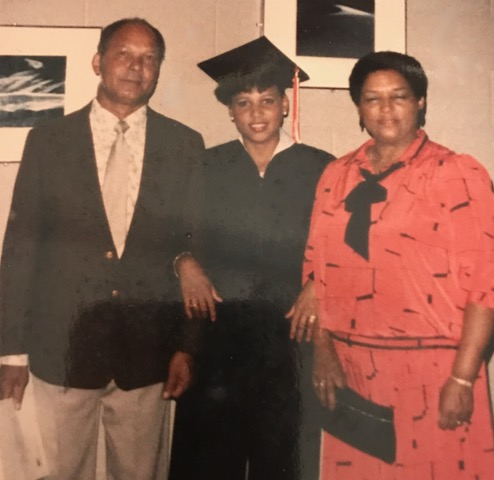 Hilton and Brenda with Lisa on her graduation
Hilton and Brenda with Lisa on her graduation
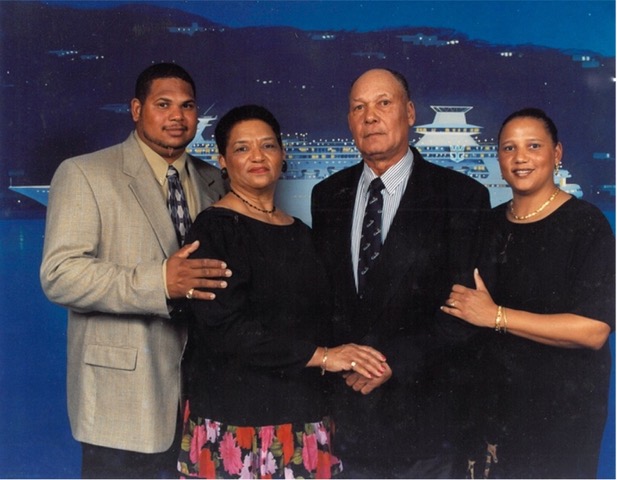 Hilton and Brenda with their children
Hilton and Brenda with their children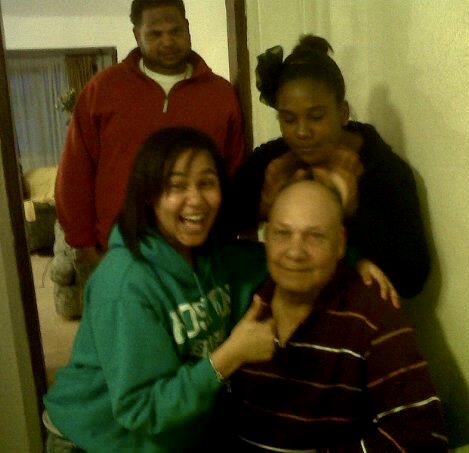
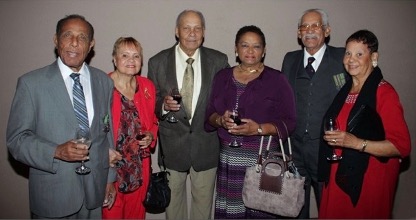 All in the Family
All in the Family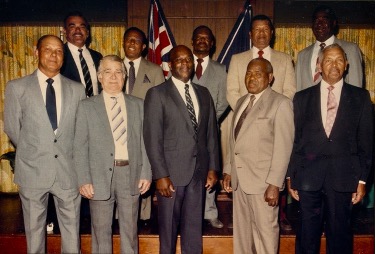
The above photo includes great stalwarts of the Bermuda Police who between them served in the Bermuda Police for over 280 years, starting with young P.C. Howard Mitchell who joined at the height of World War II in 1942, through to the retirement of "Penny" Bean in 1991. Hilton had served for 31 years.